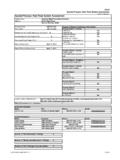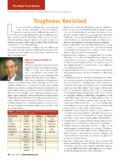Transcription of Biological Wastewater Treatment
1 IntroductionBiological Treatment is an important and integral part of any Wastewater Treatment plant that treats Wastewater from either municipality or industry having soluble organic impurities or a mix of the two types of Wastewater sources. The obvious economic advantage, both in terms of capital investment and operating costs, of Biological Treatment over other Treatment processes like chemical oxidation; thermal oxidation etc. has cemented its place in any integrated Wastewater Treatment plant. Biological Treatment using aerobic activated sludge process has been in practice for well over a century. Increasing pressure to meet more stringent discharge standards or not being allowed to discharge treated effluent has led to implementation of a variety of advanced Biological Treatment processes in recent years. The title of this article being very general, it is not possible by any means to cover all the Biological Treatment processes.
2 It is recommended that interested readers, for deeper reading and understanding, refer to well-known reference books Wastewater Engineering by Metcalf & Eddy etc. This article briefly discusses the differences between aerobic and anaerobic Biological Treatment processes and subsequently focuses on select aerobic Biological Treatment processes/technologies. Biological Wastewater TreatmentThis article briefly discusses the differences between aerobic and anaerobic Biological Treatment processes and subsequently focuses on select aerobic Biological Treatment processes/technologies. By Arun Mittal Aerobic & Anaerobic Before we go in to the discussions of various aerobic Biological Treatment processes, it is important to briefly discuss the terms aerobic and anaerobic. Aerobic, as the title suggests, means in the presence of air (oxygen); while anaerobic means in the absence of air (oxygen).
3 These two terms are directly related to the type of bacteria or microorganisms that are involved in the degradation of organic impurities in a given Wastewater and the operating conditions of the bioreactor. Therefore, aerobic Treatment processes take place in the presence of air and utilize those microorganisms (also called aerobes), which use molecular/free oxygen to assimilate organic impurities convert them in to carbon dioxide, water and biomass. The anaerobic Treatment processes, on other hand take place in the absence of air (and thus molecular/free oxygen) by those microorganisms (also called anaerobes) which do not require air (molecular/free oxygen) to assimilate organic impurities. The final products of organic assimilation in anaerobic Treatment are methane and carbon dioxide gas and biomass. The pictures in Fig. 1 and 2 depict simplified principles of the two processes.
4 Table I summarizes the major differences in these two types of processes. From the summary in Table 1, it can be concluded 32 Water Today l August - 2011 Figure 1: Aerobic Treatment PrincipleFigure 2: Anaerobic Treatment Principlethat it is not anaerobic or aerobic Treatment , but a combination of the two types of the technologies that give an optimum configuration for those Wastewater Treatment applications where the organic impurities are at a relatively higher :Aerobic Biological Treatment TechnologiesThere are multitudes of aerobic Biological Treatment processes and technologies in literature and practice; however, for the purpose of this article, following four Biological Treatment technologies are described. After description of each process and corresponding advantages/highlights, a qualitative comparison of these technologies is tabulated. This comparison is based on an actual Wastewater Treatment application for a refinery project, where the Treatment requirement was meant for discharge of treated effluent to the sea.
5 A. Conventional Activated Sludge Process (ASP) System: This is the most common and oldest biotreatment process used to treat municipal and industrial Wastewater . Typically Wastewater after primary Treatment suspended impurities removal is treated in an activated sludge process based Biological Treatment system comprising aeration tank followed by secondary clarifier. The aeration tank is a completely mixed or a plug flow (in some cases) bioreactor where specific concentration of biomass (measured as mixed liquor suspended solids (MLSS) or mixed liquor volatile suspended solids (MLVSS)) is maintained along with sufficient dissolved oxygen (DO) concentration (typically 2 mg/l) to effect biodegradation of soluble organic impurities measured as biochemical oxygen demand (BOD5) or chemical oxygen demand (COD). The aeration tank is provided with fine bubble diffused aeration pipework at the bottom to transfer required oxygen to the biomass and also ensure completely mixed reactor.
6 Roots type air blower is used to supply air to the diffuser pipework. In several older installations, mechanical surface aerators have been used to meet the aeration requirement. The aerated mixed liquor from the aeration tank overflows by gravity to the secondary clarifier unit to separate out the biomass and allow clarified, treated water to the downstream filtration system for finer removal of suspended solids. The separated biomass is returned to the aeration tank by means of return activated sludge (RAS) pump. Excess biomass (produced during the biodegradation process) is wasted to the sludge handling and dewatering Cyclic Activated Sludge System (CASSTM): Cyclic Activated Sludge System (CASSTM) as the name suggests is one of the most popular sequencing batch reactor (SBR) processes employed to treat municipal Wastewater and Wastewater from a variety of industries including refineries and petrochemical plants.
7 Aquatech has an agreement with AECOM (erstwhile Earth Tech), UK, the licensor of this technology to supply CASS technology in India on exclusive basis to both municipal and industrial markets. This technology offers several operational and performance advantages over the conventional activated sludge process. The CASS SBR process performs all the functions of a conventional activated sludge plant ( Biological removal of pollutants, solids/liquid separation and treated effluent removal) by using a single variable volume basin in an alternating mode of operation, thereby dispensing with the need for final clarifiers and high return activated sludge pumping capacity. Water Today l August - 2011 33 The Cyclic Activated Sludge System (CASSTM), incorporates a high level of process sophistication in a configuration which is cost and space effective and offers a methodology that has operational simplicity, flexibility and reliability that is not available in conventionally configured activated sludge systems.
8 Its unique design provides an effective means for the control of filamentous sludge bulking, a common problem with conventional processes and other activated sludge systems. The essential features of the CASSTM SBR technology are the plug-flow initial reaction conditions and complete-mix reactor basin. The reactor basin is divided by baffle walls into three sections (Zone 1: Selector, Zone 2: Secondary Aeration, Zone 3: Main Aeration). Sludge biomass is intermittently recycled from Zone 3 to the Zone 1 to remove the readily degradable soluble substrate and favor the growth of the floc-forming microorganisms. System design is such that the sludge return rate causes an approximate daily cycling of biomass in the main aeration zone through the selector zone. No special mixing equipment or formal anoxic mixing sequences are required to meet the effluent discharge objectives. The basin configuration and mode of operation enables combined nitrogen and phosphorous removal mechanisms to take place through a simple one-shot control of the utilizes a simple repeated time-based sequence which incorporates: Fill Aeration (for Biological reactions) Fill Settle (for solids-liquid separation) Decant (to remove treated effluent)Advantages of CASSTM:The CASSTM SBR maximizes operational: simplicity, reliability and flexibility.
9 Important reasons for choosing CASSTM SBR over conventional constant volume activated sludge aeration and clarifier process include: Operates under continuous reduced loading through simple cycle adjustment. Operates with feed-starve selectivity, So/Xo operation (control of limiting substrate to micro-organism ratio), and aeration intensity to prevent filamentous sludge bulking and ensures endogenous respiration (removal of all available substrate), nitrification and denitrification together with enhanced Biological phosphorus removal. Simultaneous (co-current) nitrification and denitrification by variation of aeration intensity. Tolerates shock load caused by organic and hydraulic load variability. The system is easily configured and adjusted for short-term diurnal and long-term seasonal 3: Conventional ASP SystemFigure 4: Typical Rectangular CASSTM SBR basin layoutFigure 5: Typical Rectangular CASSTM SBR Sequence of Operation34 Water Today l August - 2011 Elimination of secondary clarifier.
10 Elimination of separate load equalization. The CASSTM SBR basin is in itself an equalization basin and a clarifier with a much lower solids flux, compared to conventional clarifier design. Inherent ability to remove nutrients without chemical addition, by controlling the oxygen demand and supply. Provision for energy optimization through nutrient removal mechanisms. The feed water carbonaceous BOD used in denitrification and enhanced Biological phosphorus removal reduces overall oxygen demand and hence energy requirement. Capital and operating cost advantages. Minimum footprint and reduced land requirement. Provision for easy plant expansion through simple modular and common wall incorporates a selector zone, which offers an operational flexibility that is not obtainable in other variable volume, and constant volume, activated sludge facilities. The selector enables a simple cost effective measure for reliable plant scale-up without encountering filamentous sludge bulking.









